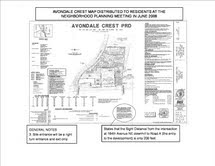 |
| The sight distance downhill is only 209 feet - far too little for drivers heading downhill to have time to stop. That's why they had the no left turn provision in the first place. It was the City of Redmond, not the developer, that pushed for the left turns into and out of the development. |
UPDATED: Avondale Crest Development was approved by the City on October 5 and is currently under appeal by Susan Wilkins.
DEVELOPMENT IS A SERIOUS DANGER TO DRIVERS ON EDUCATION HILL
No access from Avondale Road
By Susan Wilkins
Education Hill, Redmond
OPINION: When the Avondale Crest housing development was first proposed in 2005, the City of Redmond told the developer that access to the site had to be along NE 104
th Street even though the 2.85-acre property also bordered Avondale Road. (RCDG 20D.210.20-080*) The slope of the hillside created blind spots for drivers along NE 104
th Street so the original plan prohibited traffic coming down the hill from stopping and turning left into the new development. It also allowed only right turns for cars leaving the development – no left turns out of the development were allowed. (See the attached site map.) Even with the turning restrictions, more than 25 residents wrote to the city expressing concern and even alarm at the proposed site entrance because it was in a blind spot on the hill.
(Note: When a housing development is created from a larger lot or group of lots, there are two parts: the PLAT and the PRD (Planned Residential Development). The PLAT subdivides the land into smaller residential lots with the necessary street(s) and lot boundary lines. The PRD defines the requirements within the new neighborhood including house sizes, sewer lines, street lights, tree retention, open space requirements, etc. Plats and PRDs are usually designed and developed simultaneously and depend on each other - as was the case with Avondale Crest.)
When the Avondale Crest PLAT was issued on October 17, 2006, it required the installation of a fixed radar system on eastbound NE 104
th Street and it also required a Stopping Sight Distance of 450 feet along NE 104
th Street meaning that cars traveling down the hill should be able to see the entrance to Avondale Crest from 450 feet uphill.
The restriction on left turns into and out of the development had disappeared.
I appealed the Plat and a hearing was held on December 11, 2006. I presented photos showing that it was impossible to see cars turning into the Avondale Crest development from 400 feet uphill because the road bends while dropping vertically. I argued that the lack of visibility of cars stopped down-slope on NE 104
th Street would create a dangerous rear-end collision hazard. The traffic engineer and the planner for the City argued that because the fixed radar system would be installed to slow cars down to 25 mph, the 450-foot sight distance had been mitigated. The Hearing examiner sided with the City and approved the PRD and denied my PLAT appeal. I appealed to the City Council asking that the restriction on the NO LEFT TURN INTO AND OUT OF THE DEVELOPMENT be reinstated. Redmond City Council declined to add that requirement although they left open the possibility of requiring it later.
The fixed radar system was installed in early 2012 and data recorded by the system shows that fewer than 25% of cars are traveling along at the posted speed limit of 25 mph and more than 5% travel at least 10 miles over the speed limit. The data also shows that the number of vehicles exceeding the speed limit has steadily increased indicating that almost all drivers have started to ignore the fixed radar system altogether. I have often driven behind cars that the system recorded at 40+ mph - which is too fast to stop for turning traffic at Avondale Crest.
The Avondale Crest Plat that was approved in 2007 finally expired this past spring (after the City had granted multiple extensions.) Prime Pacific Bank that acquired the property when the developer went bankrupt decided that they would act as a developer and reapplied for plat approval.
Instead of re-evaluating the project with the new data from the fixed radar system – and requiring that the developer add turning restrictions on NE 104th Street, the City instead approved the plat. The previous 450-foot stopping sight distance from the Redmond Municipal Code was no longer used and instead the planning staff used a new sight distance calculation from the new Redmond Zoning Code that seems to have far shorter sight distances and stopping requirements.
We now have a fixed radar system that actually tells us that cars are going too fast down NE 104
th Street to stop for turning traffic at the proposed Avondale Crest intersection. It is obvious in 2006 when the project was originally approved that the entrance to the development was difficult to see and extremely dangerous. The proposed intersection is currently marked with orange tape and chalk. Can you see the entrance when you drive down the hill? Will you be able to stop for turning cars or crossing pedestrians? Are you afraid that you’ll be in an accident at this intersection? I am.
What should be done? The Redmond City Council should vote to amend the Avondale Crest PRD – an amendment that they specifically agreed to consider in the future when they approved the PRD. They should do it now.
-------
*During the past decade, the City of Redmond has allowed 3 other corner developments (PCC Market, Fairwinds Retirement Center and Aegis Living) to have direct access onto Avondale Road so it’s not clear why Avondale Crest was not allowed to have an exit and entrance onto Avondale, especially considering the acute danger presented by the sight distance limitations on the steep hill.






